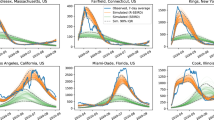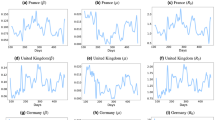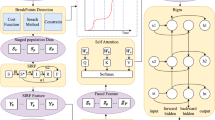Abstract
Epidemic spread in a population is traditionally modeled via compartmentalized models which represent the free evolution of disease in the absence of any intervention policies. In addition, these models assume full observability of disease cases and do not account for under-reporting. We present a mathematical model, namely PolSIRD, which accounts for the under-reporting by introducing an observation mechanism. It also captures the effects of intervention policies on the disease spread parameters by leveraging intervention policy data along with the reported disease cases. Furthermore, we allow our recurrent model to learn the initial hidden state of all compartments end-to-end along with other parameters via gradient-based training. We apply our model to the spread of the recent global outbreak of COVID-19 in the USA, where our model outperforms the methods employed by the CDC in predicting the spread. We also provide counterfactual simulations from our model to analyze the effect of lifting the intervention policies prematurely and our model correctly predicts the second wave of the epidemic.




Similar content being viewed by others
Notes
“Pol” stands for policies
Note that all policies still have their own unique decay rates and steady-state reductions. We do not share those parameters among different policies.
However, the actual reproduction number is less and is explored in Section 4.4.
References
Kermack WO, McKendrick AG (1927) A contribution to the mathematical theory of epidemics. Proc Royal Soc London Ser A Contain Pap Math Phys Char 115(772):700–721
Imai N, Cori A, Dorigatti I, Baguelin M, Donnelly CA, Riley S, Ferguson NM (2020) Report 3 - transmissibility of 2019-ncov. MRC Centre for Global Infectious Disease Analysis COVID-19
Allen LJ (1994) Some discrete-time si, sir, and sis epidemic models. Math Biosci 124(1):83–105
Rvachev LA, Longini Jr IM (1985) A mathematical model for the global spread of influenza. Math Biosci 75(1):3–22
Longini Jr IM (1986) The generalized discrete-time epidemic model with immunity: a synthesis. Math Biosci 82(1):19–41
Flahault A, Deguen S, Valleron A-J (1994) A mathematical model for the european spread of influenza. European J Epidemiol 10(4):471–474
Kim M, Paini D, Jurdak R (2019) Modeling stochastic processes in disease spread across a heterogeneous social system. Proc Nat Acad Sci 116 (2):401–406
Linderman SW, Adams RP (2015) Scalable bayesian inference for excitatory point process networks. arXiv:1507.03228
Rizoiu M-A, Mishra S, Kong Q, Carman M, Xie L (2018) Sir-hawkes: linking epidemic models and hawkes processes to model diffusions in finite populations. In: Proceedings of the 2018 world wide web conference, pp 419–428
Siettos CI, Russo L (2013) Mathematical modeling of infectious disease dynamics. Virulence 4(4):295–306
Chowell G, Sattenspiel L, Bansal S, Viboud C (2016) Mathematical models to characterize early epidemic growth: a review. Phys Life Rev 18:66–97
Walters CE, Meslé MM, Hall IM (2018) Modelling the global spread of diseases: a review of current practice and capability. Epidemics 25:1–8
Verity R, Okell LC, Dorigatti I, Winskill P, Whittaker C, Imai N, Cuomo-Dannenburg G, Thompson H, Walker PG, Fu H et al (2020) Estimates of the severity of coronavirus disease 2019: a model-based analysis. Lancet Infect Dis
Xiong H, Yan H (2020) Simulating the infected population and spread trend of 2019-ncov under different policy by eir model, medRxiv
Chen Y, Cheng J, Jiang Y, Liu K (2020) A time delay dynamical model for outbreak of 2019-ncov and the parameter identification. J Inverse Ill-posed Prob 28(2):243–250
Lorch L, Trouleau W, Tsirtsis S, Szanto A, Schölkopf B, Gomez-Rodriguez M (2020) A spatiotemporal epidemic model to quantify the effects of contact tracing, testing, and containment. arXiv:2004.07641
Li R, Pei S, Chen B, Song Y, Zhang T, Yang W, Shaman J (2020) Substantial undocumented infection facilitates the rapid dissemination of novel coronavirus (sars-cov-2). Science 368(6490):489–493
Zou D, Wang L, Xu P, Chen J, Zhang W, Gu Q (2020) Epidemic model guided machine learning for covid-19 forecasts in the united states, medRxiv
Chang M-C, Kahn R, Li Y-A, Lee C-S, Buckee CO, Chang H-H (2020) Modeling the impact of human mobility and travel restrictions on the potential spread of sars-cov-2 in Taiwan, medRxiv
Chinazzi M, Davis JT, Ajelli M, Gioannini C, Litvinova M, Merler S, Piontti APY, Mu K, Rossi L, Sun K et al (2020) The effect of travel restrictions on the spread of the 2019 novel coronavirus (covid-19) outbreak. Science 368(6489):395–400
Dandekar R, Barbastathis G (2020) Quantifying the effect of quarantine control in covid-19 infectious spread using machine learning, medRxiv
Li ML (2020) Overview of DELPHI model v2.0. MIT Operations Research Center, Tech. Rep.
Bertozzi AL, Franco E, Mohler G, Short MB, Sledge D (2020) The challenges of modeling and forecasting the spread of covid-19. arXiv:2004.04741
Dong E, Du H, Gardner L (2020) An interactive web-based dashboard to track covid-19 in real time. Lancet Infect Dis
Bureau USC (2020) Population, population change, and estimated components of population change: April 1, 2010 to July 1, 2019 (nst-est2019-alldata), http://www.census.gov
Killeen BD, Wu JY, Shah K, Zapaishchykova A, Nikutta P, Tamhane A, Chakraborty S, Wei J, Gao T, Thies M, Unberath M (2020) A county-level dataset for informing the united states’ response to covid-19
Couture V, Dingel J, Green A, Handbury J, Williams K (2020) Exposure indices derived from placeIQ movement data, https://github.com/COVIDExposureindices/COVIDExposureindices
Balcan D, Gonçalves B, Hu H, Ramasco JJ, Colizza V, Vespignani A (2010) Modeling the spatial spread of infectious diseases: the global epidemic and mobility computational model. J Comput Sci 1(3):132–145
NR et al (2020) COVID-19 Forecast Hub. [Online]. Available: https://github.com/reichlab/covid19-forecast-hub
Smith C, Miller B, Taylor PW (2020) Reopening the economy under covid-19: States plot a way back. [Online]. Available: https://www.governing.com/now/Reopening-the-Economy-Under-COVID-19-States-Plot-a-Way-Back.html
Acknowledgements
This research was supported in part by NSF Career award 1254206, NSF FMitF award 1837131 and the USC Viterbi Graduate PhD fellowship.
Author information
Authors and Affiliations
Corresponding author
Ethics declarations
Conflict of Interest
The authors declare no competing interests.
Additional information
Publisher’s Note
Springer Nature remains neutral with regard to jurisdictional claims in published maps and institutional affiliations.
This article belongs to the Topical Collection on Special Collection on COVID-19
Guest Editors: Christopher C. Yang, Julio Cesar Facelli, David Buckeridge, Fei Wang
Appendix: GraphPolSIRD: Spatial Transport with PolSIRD
Appendix: GraphPolSIRD: Spatial Transport with PolSIRD
In this section, we describe the more detailed GraphPolSIRD model which collectively models both the temporal and the spatial evolution of a pandemic. Consider a set of M heterogeneous populations (e.g., the M = 50 for the US states) as nodes in a graph \(\mathbb {G}\). We assume that the population on a node can be assumed to mix homogeneously within itself while the populations between two nodes require traveling to mix. There exists a directed edge from node i to node j in the graph if people can travel from i to j. The edge weight denoted by fij is proportional to the frequency at which residents of node i travel to node j and come back. Note that fij may not be equal fji since some states like New York may be popular tourist/business destinations while others like Alaska might experience a limited number of visitors (hence fAK,NY ≫ fNY,AK). An estimate of these travel frequencies is required from travel data for the GraphPolSIRD model. For our experiment results in Section 4.2, we used the PlaceIQ movement data derived from anonymized, aggregated smartphone movements provide by PlaceIQ [27]. Note that while we assume these travel frequencies fij to be averaged constants independent of time, in practice this may not be the case. If non-aggregated daily travel frequencies are available, our GraphPolSIRD model also admits using them instead. However, for our application to COVID-19 modeling, only aggregated travel frequencies were available and hence we describe a simpler version of GraphPolSIRD with constant graph edge weights fij independent of time.
At any time t, the state G(t) of graph \(\mathbb {G}\) is described by the compartment populations at all the nodes, i.e., \(G(t) = \{S_{i}(t), I_{i}(t), \tilde {I}_{i}(t), R_{i}(t), \tilde {D}_{i}(t), \tilde {C}_{i}(t)\}_{i \in [M]}\). The population conservation equation still applies independently at all nodes:
The evolution from time t to t + 1 is now governed by a cascade of two operators, denoted as \(\mathbb {T}\) (the temporal evolution operator) and \(\mathbb {S}\) (the spatial evolution operator), i.e.,
The temporal operator \(\mathbb {T}\) applies to each node individually and is governed by the same set of (6)–(13) described in Section 3. Here, we describe the spatial operator \(\mathbb {S}\) which applies to the graph \(\mathbb {G}\) as a whole and models the effect of epidemic spread due to travel between the heterogeneously mixing populations at different nodes.
The spatial operator \(\mathbb {S}\) affects only the susceptible and the unreported infectious compartments at a node due to the presence of infected population traveling to it from adjacent nodes. We assume that reported infected individuals refrain from traveling (or the number of such individuals traveling is small enough to be neglected); hence, the inter-node spread happens primarily due to unreported infected individuals traveling between nodes. Hence, the spatial operator reduces the susceptible population and increases the infected population at each time step at every node i ∈ [M] as follows:
where the term being subtracted from Si(t) and being added to Ii(t) are the number of individuals getting affected at node i at time step t due to unreported infected individuals traveling from neighboring nodes j ∈ [M] ∖{i}. Note that the term \(N_{j} - \tilde {I}_{j}(t) - \tilde {D}_{j}(t)\) is the total traveling population (since reported infected individuals and dead individuals do not travel) and the term \(\frac {I_{j}(t)}{N_{j} - \tilde {I}_{j}(t) - \tilde {D}_{j}(t)}\) gives the number of unreported infected population as a fraction of the total population traveling. When multiplied by the average number of people travelling from node j to node i, i.e., fji (a.k.a. travel frequency), the term \(f_{ji} \frac {I_{j}(t)}{N_{j} - \tilde {I}_{j}(t) - \tilde {D}_{j}(t)}\) gives the number of unreported infected people traveling from node j to node i. The constant \(\sigma \in (0, \infty )\) is an additional learnable parameter of the GraphPolSIRD model which stands for the number of people infected at the destination node per traveling person from a source node. This parameter is learnt end-to-end with gradient descent along with the other learnable parameters described in Section 3.4. Note that since we have the learnable parameter σ multiplying with the travel frequencies fji, it can account for any magnitude changes in the fij coefficients. This implies that we do not necessarily need exact travel frequencies. Instead, one can use any available quantities proportional to them. This is a very useful property since the PlaceIQ movement data [27] does not provide us exact travel frequencies but rather the fraction of smartphones in state A on the current day that pinged in any of the other states in the last 15 days. This quantity is roughly proportional to the travel frequencies but does not reflect their exact magnitude; however, our learnable parameter σ can to adapt to any scaling in the magnitudes.
Finally, the spatial operator does not change any other compartments or observables other than S and I. Hence, after the spatial operator \(\mathbb {S}\), we can apply the temporal operator \(\mathbb {T}\) to the graph state \(G(t) = \{S_{i,\mathbb {S}}(t), I_{i,\mathbb {S}}(t), \tilde {I}_{i}(t),R_{i}(t), \tilde {D}_{i}(t), \tilde {C}_{i}\) (t)}i∈[M] as described in the main text to model the transition to time step t + 1.
Rights and permissions
About this article
Cite this article
Kamra, N., Zhang, Y., Rambhatla, S. et al. PolSIRD: Modeling Epidemic Spread Under Intervention Policies. J Healthc Inform Res 5, 231–248 (2021). https://doi.org/10.1007/s41666-021-00099-3
Received:
Revised:
Accepted:
Published:
Issue Date:
DOI: https://doi.org/10.1007/s41666-021-00099-3




